22 April 2015. Burlington, ON. There are ducks, and then there are ducks. The good old ‘puddle ducks’ as stereotyped by Walt Disney and Beatrice Potter, include many from the genus Anas. Mallards, (Anas platyrhynchos) Green-winged Teal (Anas crecca) and Northern Shovelers (Anas clypeata) for example. There are many other large, free-floating birds that we generically label as ducks but they are not all as endearing or cuddly as the Anas crowd.
It is common among ducks of all types for the drakes to be quite spectacular dressers: always classy, often tasteful, sometimes colourful and occasionally all three. Females in the Anas family are sometimes quite difficult to tell apart, one species from the other. They are commonly mottled browny-grey all over, effective camouflage when incubating but hardly head-turning.
This morning, as part of my census circuit, I enjoyed watching four species of duck: Mallard, Wood Duck, Blue-winged Teal and Gadwall; in every case there were bonded pairs, and in the case of the Wood Ducks there were many males without females in evidence. (For the record, Wood Ducks, along with the outrageously ornate Mandarin Duck of Asia belong in the genus Aix. Wood Ducks are Aix sponsa.)
The Blue-winged Teals were my Birds of the Day. It is a species in decline, perhaps due to over-hunting on their wintering grounds. Formerly quite common during spring and summer, we don’t see them much any more. They pass through in the early spring (about now) and it always seems to be a brief visit. At a distance, the male is easy to identify with his white facial crescent and bum-patch. Closer up, the rich cinnamon of his breast and flanks puts him in the tasteful dresser category. This pair was hard to see working the dark edge of some old vegetation, then a passing Cooper’s Hawk panicked everyone but when everything had calmed down, the pair settled back in the open water close to where I could get this shot.
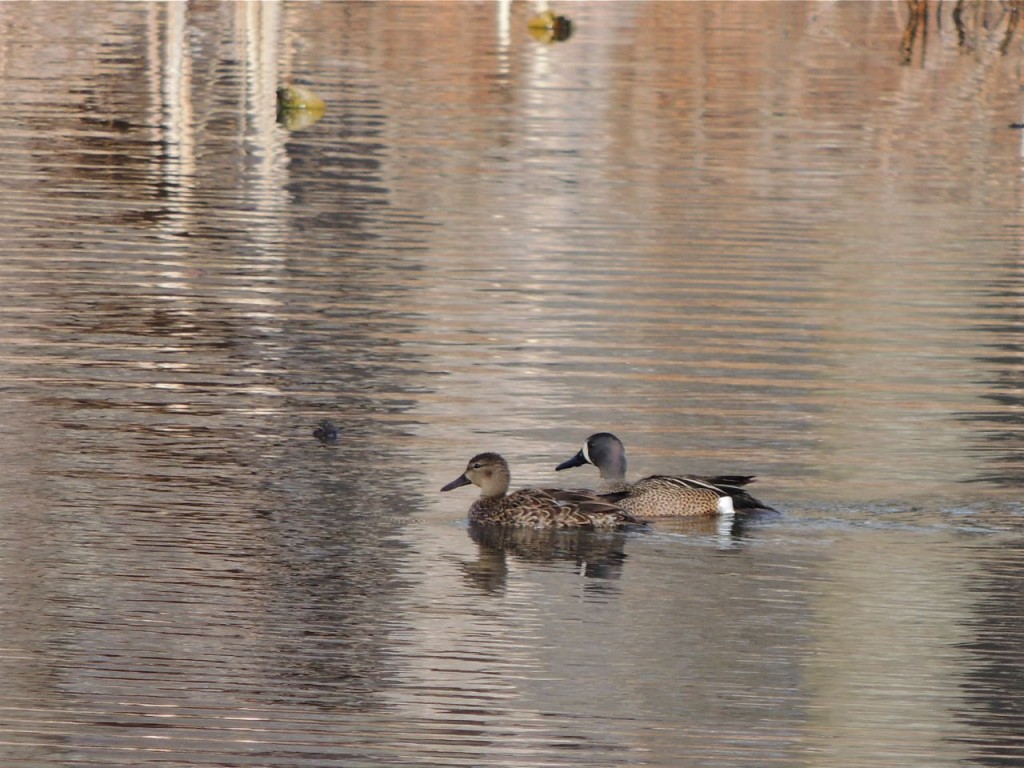
My census route encompasses a couple of large ponds which Wood Ducks find very appealing, probably because of the encircling oak woodland. Wood Ducks are so called because they seek mature deciduous trees with lots of natural nesting cavities. They choose a safe hideaway, far above the forest floor and there the female incubates a clutch of perhaps as many as a dozen eggs. When the ducklings hatch they waste no time leaving the nest, the female calls to them from the forest floor below and the featherweight babes jump, and more or less float down to the leaf litter; then they follow mother to the nearest water. Hard to imagine.
I found twenty-one Wood Ducks today, mostly males. I suspect a balancing number of females were preoccupied in their nest holes and incubating this year’s brood. Wood Ducks are distinctive for several reasons and foremost has to be the astonishing plumage of the male. It is a crazy collage of colours: maroon, bottle green, scarlet and cream; and shapes: crescents, slashes and curlicues. The female is no shrinking violet either. She doesn’t go for the exuberance of the male, instead she is a study in soft iridescence and eye make-up; no wonder he’s falls for her. I’ve included several photos of the couple in the gallery below. It’s interesting how, in the riot of spring colours and reflections, this pair quite successfully merge into the background; the female more so than the male. Nearby was another pair of Wood Ducks; each with its own log they watched me nervously. They were a pretty picture, so I’ve included them in the gallery (Visible only on the website, not if you’re reading this as an email.)
Finally as I was about to wrap up my census I watched a Belted Kingfisher successfully fishing, plunging every few minutes and returning to gulp down little wriggly fish. Here are a couple of shots. (Click each to enlarge) Too bad I didn’t use a faster shutter speed.
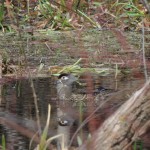
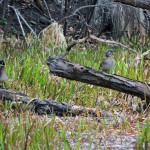
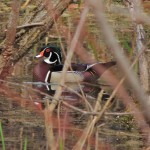
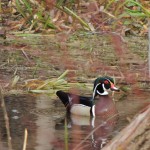
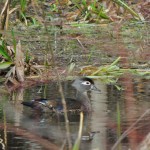
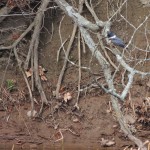
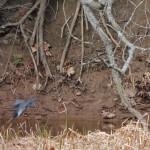
Lovely stories and photos, as always!
Thanks!